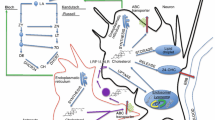Abstract
Cholesterol and α-tocopherol oxidations were studied in brain subcellular fractions isolated from cerebral hemispheres of 4-month-old, male Fischer 344 rats. The fractions were suspended in buffered media (pH 7.4, 37°C) and oxidized by adding (i) ferrous iron (Fe2+) with or without ascorbate or (ii) peroxynitrite (an endogenous oxidant produced by the reaction of superoxide and nitric oxide). Treatment of subcellular fractions with Fe2+ in the presence or absence of ascorbate produced primarily 7-keto- and 7-hydroxy-cholesterols and small amounts of 5α,6α-epoxycholesterol. Since brain contains high levels of ascorbate, any release of iron could result in oxysterol formation. Peroxynitrite oxidized α-tocopherol but not cholesterol. Hence, the toxicity of peroxynitrite or nitric oxide could not be due to cytotoxic oxysterols. When synaptosomes were incubated for 5 min in the presence of 0.5 to 2 μM Fe2+ and ascorbate, α-tocopherol was oxidized while cholesterol remained unchanged. Thus, α-tocopherol is functioning as an antioxidant, protecting cholesterol. Diethylenetriaminepentaacetic acid blocked production of oxysterols, whereas citrate, ADP and EDTA dit not. A significant percentage of mitochondrial cholesterol was oxidized by treatment with Fe2+ and ascorbate. Hence, mitochondrial membrane properties dependent on cholesterol could be particularly susceptible to oxidation. The oxysterols formed were retained within the membranes of synaptosomes and mitochondria. The 7-oxysterols produced are known to be inhibitors of membrane enzymes and also can modify membrane permeability. Hence, oxysterols may play an important role in brain tissue damage during oxidative stress.
Similar content being viewed by others
Abbreviations
- DTPA:
-
diethylenetriaminepentaacetic acid
- TMCS:
-
trimethylchlorosilane
- trivial names of sterols: cholest-5-ene-3β,7α-diol:
-
7α-hydroxycholesterol
- cholest-5-ene-3β,7β-diol:
-
7β-hydroxycholesterol
- 3β-hydroxycholest-5-ene-7-one:
-
7-ketocholesterol
- 5,6,α-epoxy-5α-cholestan-3β-ol:
-
5α,6α-epoxycholesterol
References
Smith, L.L. (1987) Cholesterol Autoxidation 1981–1986, Chem. Phys. Lipids 44, 87–125.
Smith, L.L., and Johnson, B.H. (1989) Biological Activities of Oxysterols, Free Radical Biol. Med. 7, 285–332.
Vatassery, G.T. (1993) Oxidation of Alpha-Tocopherol in Subcellular Fractions from Rat Brain and Its Possible Involvement in Nerve Function, Biochem. Pharmacol. 45, 2295–2301.
Markwell, M.A.K., Haas, S.M., Bieber, L.L., and Tolbert, N.E. (1978) A Modification of the Lowry Procedure to Simplify Protein Determination in Membrane and Lipoprotein Samples, Anal. Biochem. 87, 206–210.
Vatassery, G.T., Smith, W.E., and Quach, H.T. (1993) A Liquid Chromatographic Method for the Simultaneous Determination of Alpha-Tocopherol and Tocopherolquinone in Human Red Blood Cells and Other Biological Samples Where Tocopherol Is Easily Oxidized During Sample Treatment, Anal. Biochem. 214, 426–430.
Vatassery, G.T., Quach, H.T., Smith, W.E., Krick, T.P., and Ungar, F. (1997) Analysis of Hydroxy and Keto Cholesterols in Oxidized Brain Synaptosomes, Lipids 32, 101–107.
Lai, J.C.K., and Clark, J.B. (1989) Isolation and Characterization of Synaptic and Nonsynaptic Mitochondria from Mammalian Brain, in Neuromethods. Volume 11: Carbohydrates and Energy Metabolism (Boulton, A.A., and Baker, G.B., eds.), pp. 43–97, Humana Press, Clifton.
Maynard, R.R., Fullerton, D.S., and Ahmed, K.A. (1982) A Simple Method for the Purification of Rat Brain Na, K Adenosine Triphosphatase, J. Pharmacolog. Meth. 7, 279–288.
Keith, W.G., and Powell, R.E. (1969) Kinetics of Decomposition of Peroxynitrous Acid, J. Chem. Soc. (A), 90.
Hughes, M.N., and Nicklin, H.G. (1968) The Chemistry of Pernitrites. Part 1. Kinetics of Decomposition of Pernitrous Acid. J. Chem. Soc. (A), 450–452.
Carpenter, K.L.H., Ballantine, J.A., Fussell, B., Enright, J.H., and Mitchinson, M.J. (1990) Oxication of Cholesteryl Linoleate by Human Monocyte-Macrophages in vitro, Atherosclerosis 83, 217–229.
Burkitt, M.J., and Gilbert, B.C. (1990) Model Studies of the Iron-Catalyzed Haber-Weiss Cycle and the Ascorbate-Driven Fenton Reaction, Free Radical Res. Comm. 10, 265–280.
Rajalakshmi, R., Malathy, J., and Ramakrishnan, C.V. (1967) Effect of Dietary Protein Content on Regional Distribution of Ascorbic Acid in Rat Brain, J. Neurochem. 14, 161–167.
Vatassery, G.T. (1992) Vitamin E: Neurochemistry and Implications for Parkinson’s Disease, Ann. N.Y. Acad. Sci. 669, 97–110.
Lijana, R.C., McCracken, M.S., and Rudolph, C.J. (1986) The Oxidation of Cholesterol in Vesicles, Biochim. Biophys. Acta 879, 247–252.
Gutteridge, J.M.C., and Halliwell, B. (1990) The Measurement and Mechanism of Lipid Peroxidation in Biological Systems, Trends Biochem. Sci. 15, 129–135.
Vatassery, G.T. (1995) In vitro Oxidations of Vitamins C and E, Cholesterol, and Thiols in Rat Brain Synaptosomes, Lipids 30, 1007–1013.
Lin, Y.Y., and Smith, L.L. (1974) Sterol Metabolism XXVIII. Biosynthesis and Accumulation of Cholest-5ene-3b-24-diol (Cerebrosterol) in Developing Rat Brain, Biochim. Biophys. Acta 348, 189–196.
Lin, Y.Y., and Smith, L.L. (1975) The Disposition of [24-3H] Cerebrosterol in Developing Rat Brain, J. Neurochem. 25, 659–665.
Sevanian, A., and Mcleod, L.L. (1987) Cholesterol Autoxidationin Phospholipid Membrane Bilayers, Lipids 22, 627–636.
Guo, X., Ohno, Y., Miyajima, A., Sunouchi, M., and Takanaka, A. (1993) Oxysterols Inhibit Gap Junctional Communication Between Rat Hepatocytes in Primary Culture, Pharmacol. Toxicol. 73, 10–13.
Theunissen, J.J.H., Jackson, R.L., Kempen, H.J.M., and Demel, R.A. (1986) Membrane Properties of Oxysterols. Interfacial Orientation, Influence on Membrane Permeability and Redistribution Between Membranes, Biochim. Biophys. Acta 860, 66–74.
Kandutsch, A.A., Chen, H.W., and Heiniger, H.J. (1978) Biological Activity of Some Oxygenated Sterols, Science 201, 498–501.
Goldstein, J.L., and Brown, M.S. (1990) Regulation of the Mevalonate Pathway, Nature 343, 425–430.
Author information
Authors and Affiliations
Corresponding author
About this article
Cite this article
Vatassery, G.T., Quach, H.T., Smith, W.E. et al. Oxidation of cholesterol in synaptosomes and mitochondria isolated from rat brains. Lipids 32, 879–886 (1997). https://doi.org/10.1007/s11745-997-0113-1
Received:
Revised:
Accepted:
Issue Date:
DOI: https://doi.org/10.1007/s11745-997-0113-1




